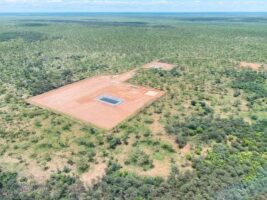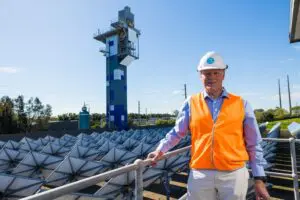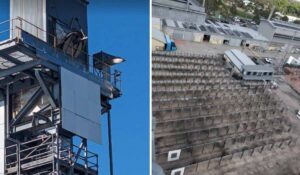The University of Newcastle has welcomed the ‘real-world’ deployment of its flexible and printable solar model innovations that researchers hope will accelerate the commercialisation of the “disruptive” technology.
The flexible and printable solar cells have received their first real-world installation, after being integrated into new shade structures as part of a new public space development being undertaken by the Lane Cove Council.
The Canopy is a major redevelopment being undertaken by the Lane Cove Council to create a public green space which features a number of sustainability measures, including rainwater capture, a green wall and electric vehicle charging stations, and will become one of the world’s first public deployments of the printable solar cells.
“Located within Lane Cove Council’s vibrant new urban space ‘The Canopy’, this demonstration plucks extraordinary science from behind sealed lab doors, and places it in an ordinary environment, where people will interact with it as they go about their grocery shopping, play with their children in the park, or enjoy food in one of the nearby restaurants,” the University of Newcastle’s Professor Paul Dastoor said.
“It’s an effortless and subtle way to spark conversation and showcase ‘what’s next’ in energy generation to thousands of people.”
The solar modules have been developed by the University of Newcastle, with lead inventor professor Paul Dastoor from the university’s faculty of science saying that a real-world deployment of the technology would help accelerate commercialisation, allowing for the performance and long-term durability of the panels to be tested.
“Globally, there’s been so few of these installations, we know very little about how they perform in a public setting. This installation is the next critical step in accelerating the development and commercialisation of this technology. It presents a new scenario for us to test performance and durability against a range of new challenges,” Professor Dastoor added.
The printable solar panels use organic solar cell techniques that provide a significant increase in flexibility compared to conventional solar cells that rely on stiff and brittle silicon solar wafers.
The printable solar cells draw upon advances in perovskite solar cell technologies, much of which is being advanced by Australian research institutions, that have the promise of low cost yet adaptable solar power applications, including the prospect of being integrated into the surfaces of buildings or electric vehicles.
The University of Newcastle’s solar cell innovations have previously been used in a commercial deployment at a CHEP logistics hub near Newcastle. The latest deployment in partnership with the Lane Cove Council will be the first time the University of Newcastle’s printable solar modules will be publicly viewable.
The ability to produce the flexible solar panels on-demand, with the materials being suitable for use in commercial printing equipment is another key advantage, and professor Dastoor believes that this could be a major disrupter in both the energy and commercial printing industries.
“This technology will really disrupt and revitalise the contracting print industry. Printed solar is manufactured on conventional printers – our lab-scale system previously manufactured wine labels,” Dastoor said.
“As a diverse team of physicists, chemists, engineers and educators, we’re considering not just the scaling of material production, but the education and training framework that will wrap around the industry to train and retrain an entirely new workforce.”
The organic solar cells have been integrated into a flexible protective layer manufactured from PET materials, allowing for more than 99 per cent of the solar modules to be recycled at the end of their operational life.
Professor Dastoor added that he believed innovations of this type will be needed as part of a push to reduce global emissions and should receive further research support from the federal government.
“The government is seeking to bring down carbon emissions over the next 30 years and the community has been very engaged on this subject. Globally, there are many research groups like ours working on sustainable energy technologies and now, via the technology investment roadmap, is our opportunity to ensure we invest in and deliver clever solutions,” Professor Dastoor added.
A similar demonstration of printable solar cells, as developed by the CSIRO has previously been undertaken at the Melbourne Zoo, where they have likewise been integrated into a canopy shade structures.










